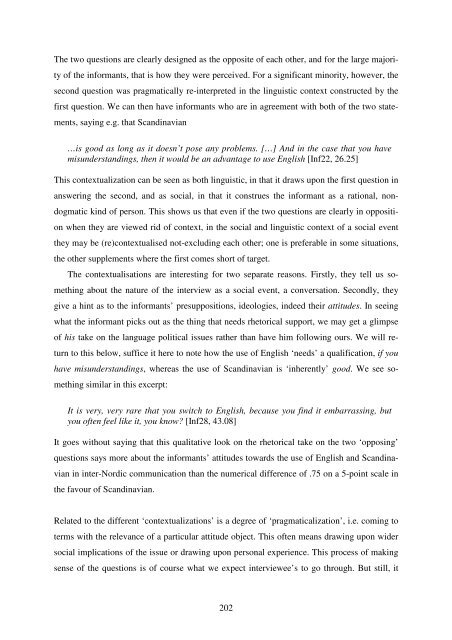Hør dog hvad de siger - Note-to-Self: Trials & Errors
Hør dog hvad de siger - Note-to-Self: Trials & Errors
Hør dog hvad de siger - Note-to-Self: Trials & Errors
Create successful ePaper yourself
Turn your PDF publications into a flip-book with our unique Google optimized e-Paper software.
The two questions are clearly <strong>de</strong>signed as the opposite of each other, and for the large majori-<br />
ty of the informants, that is how they were perceived. For a significant minority, however, the<br />
second question was pragmatically re-interpreted in the linguistic context constructed by the<br />
first question. We can then have informants who are in agreement with both of the two state-<br />
ments, saying e.g. that Scandinavian<br />
…is good as long as it doesn’t pose any problems. […] And in the case that you have<br />
misun<strong>de</strong>rstandings, then it would be an advantage <strong>to</strong> use English [Inf22, 26.25]<br />
This contextualization can be seen as both linguistic, in that it draws upon the first question in<br />
answering the second, and as social, in that it construes the informant as a rational, non-<br />
<strong>dog</strong>matic kind of person. This shows us that even if the two questions are clearly in oppositi-<br />
on when they are viewed rid of context, in the social and linguistic context of a social event<br />
they may be (re)contextualised not-excluding each other; one is preferable in some situations,<br />
the other supplements where the first comes short of target.<br />
The contextualisations are interesting for two separate reasons. Firstly, they tell us so-<br />
mething about the nature of the interview as a social event, a conversation. Secondly, they<br />
give a hint as <strong>to</strong> the informants’ presuppositions, i<strong>de</strong>ologies, in<strong>de</strong>ed their attitu<strong>de</strong>s. In seeing<br />
what the informant picks out as the thing that needs rhe<strong>to</strong>rical support, we may get a glimpse<br />
of his take on the language political issues rather than have him following ours. We will re-<br />
turn <strong>to</strong> this below, suffice it here <strong>to</strong> note how the use of English ‘needs’ a qualification, if you<br />
have misun<strong>de</strong>rstandings, whereas the use of Scandinavian is ‘inherently’ good. We see so-<br />
mething similar in this excerpt:<br />
It is very, very rare that you switch <strong>to</strong> English, because you find it embarrassing, but<br />
you often feel like it, you know? [Inf28, 43.08]<br />
It goes without saying that this qualitative look on the rhe<strong>to</strong>rical take on the two ‘opposing’<br />
questions says more about the informants’ attitu<strong>de</strong>s <strong>to</strong>wards the use of English and Scandina-<br />
vian in inter-Nordic communication than the numerical difference of .75 on a 5-point scale in<br />
the favour of Scandinavian.<br />
Related <strong>to</strong> the different ‘contextualizations’ is a <strong>de</strong>gree of ‘pragmaticalization’, i.e. coming <strong>to</strong><br />
terms with the relevance of a particular attitu<strong>de</strong> object. This often means drawing upon wi<strong>de</strong>r<br />
social implications of the issue or drawing upon personal experience. This process of making<br />
sense of the questions is of course what we expect interviewee’s <strong>to</strong> go through. But still, it<br />
202



